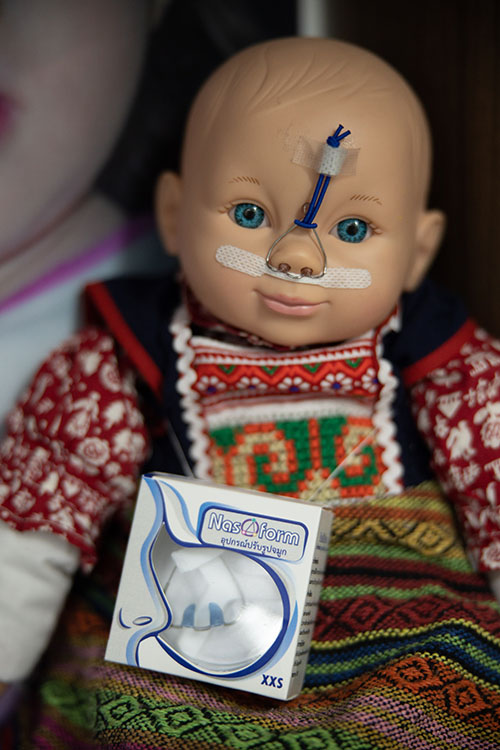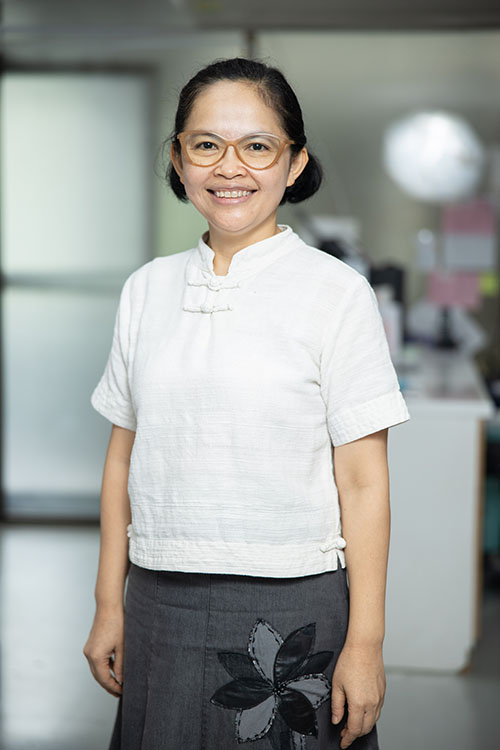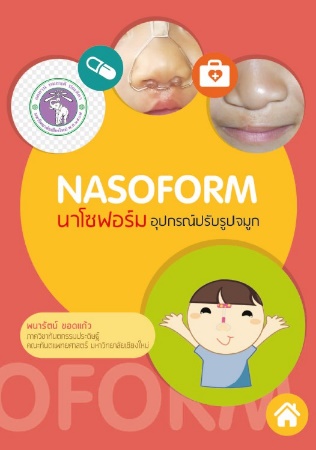Namo, integral to the successful development of Nasoform
As someone once said, “The most beautiful smiles in the world are the smiles of children.” Sadly, some children are afraid to smile because they have a deformed nose and smiling would make the abnormality more apparent.
These children were born with the incomplete formation of lips and palates which lead to abnormality in their faces which in turn lead to abnormality in communication between oral and nasal cavities. This means that they will have to deal with problems such as poor facial appearance, food leakage through the nose, mouth breathing, hearing loss, unclear speech, crooked teeth, and more throughout their lives. In order to avoid these problems, these children need several corrective surgeries and required long term treatment by multidisciplinary medical teams from birth until the age of 20 years. Of course, during that time they inevitably suffer both physically and mentally.
Both patients and their families often complain of being tired with this lengthy treatment; many times doctors too are discouraged by the poor results of treatments. One particularly disheartening failure is the problem of the collapse of the nose following surgical correction. It was this failure that led to innovation which came about through the cooperation of three sectors of Chiang Mai University: The Oral and Maxillofacial Prosthetics Rehabilitation Center, Faculty of Dentistry, The Princess Sirindhorn IT Foundation Craniofacial Center and The Technology Licensing Office and University Business Incubator (TLOUBI). Since 2013, an appliance called Nasoform has been successful in solving the problems of nose collapse following surgical correction and lead to the reduction of demand for cleft lip nose revisions.
Following successful surgeries, children with cleft lips and cleft palates who used the Nasoform appliance are no longer categorised as children with fear of smiling. Whenever they come to see the dentist at The Oral and Maxillofacial Prosthetics Rehabilitation Center, they smile happily while looking at their own pictures on the wall. Especially a nine-year-old boy named Namo, who’s featured picture comes with the caption, “without me, without my mother, maybe without Nasoform.”
Associate Professor Dr. Panarat Kodkeaw, Namo and his mother (Pimluk Intarachusri)
Children begin to learn about the differences and similarities between themselves and others at the age of one when they begin to realise that they are different in features from those around them. This leads to a lack in confidence to go out into the community to make new friends. To avoid this situation, such problems with facial features should be solved successfully as soon as possible, before children are aware of such stark differences. Other problems can then be fixed gradually in an appropriate time-frame in order for children to grow up healthy and feel as though they fit in with others around them.
The key person in the design and development process of Nasoform was Namo. Eight years ago, Namo received a cleft lip nose surgical correction and palatoplasty. At that time, he was eight months old. After the surgery, the little infant had to use a nasal stent for six months. The first piece was installed in the operation room, and sadly fell off immediately after he woke up from general anesthetic. The second piece was made after surgery, however it remained in position for only a few hours. The problem was that, as an infant, Namo could not stay still, leading his mother to ask the medical team, “It is impossible to make him wear a nasal stent all day as per the advice of the doctor. What should I do? If I cannot do this Namo will become a child with a collapsed nose who looks like the other patients who are waiting at the Out-Patient-Department (OPD) of plastic surgeon.”
Many ideas and designs were experimented upon following such a challenge. Finally, success was accomplished by using a wire attached to the side edges of the appliance that made it look like a basket for the nose which would then hang from the forehead by a tape. This allowed Namo to wear the appliance longer and was a major turning point in design, fabrication, and development of Nasoform appliance by Associate Professor Dr. Panarat Kodkeaw. The medical team had to listen closely to Pimluk Intarachusri, Namo’s mother, as she explained their difficulties and needs. By listening and finding a solution targeted to this particular problem, a new appliance was created that helped Namo, and many other children since, who have suffered from similar problems. Children who may have grown up with physical deformities are now healthy and happy children with bright smiles.
“On the day of the appointment,” explained Associate Professor Dr. Panarat, “after Namo’s mother and I had an at length discussion, I assembled an appliance for Namo using common materials and equipment found in the clinic. At that time, Nasoform was held together by many pieces of tape stuck on Namo’s face. After that meeting, however, several modifications had been done to improve the function of Nasoform. It could be said that the development of Nasoform by the team proceeded in tandem with Namo and the many other children who received cleft lip nose correction surgically by Assistant Professor Krit Khwanngern. Knowledge extracted from one family was applied to the next family. Our team collected treatment data and selected the proper techniques and methods for each new family.
From the experience of pioneering the development of Nasofom, which may appear unattractive in design and shape, children are released from the cleft stigma which indicates the congenital defects of the cleft lip and cleft palate. Now, these pioneering children are eight to nine-years-old. They are cheerful. Their faces are normal. Today the team is confident that children who use the new model of Nasoform, modified several times over the years, can achieve such standards of result.”


Associate Professor Dr. Panarat Kodkeaw and Nasoform
The aim of the medical team was to continue to develop the Nasoform to be more efficient, with a natural-looking nose being the target for success. At the same time, The Technology Licensing Office and University Business Incubator stepped in to take responsibility in the continuation of innovation and promotion of the wider application of the technology, in accordance with the mission of Chiang Mai University. This handmade appliance has since been developed into a prototype via the technology transferring process. Finally, in 2019, a private company was officially authorised by Chiang Mai University to commercialise Nasoform technology.
Nasoform has three main components: two nostril supporters, a wire framework, and a holding button. All components can be adjusted to conform with the nose shape of each individual child. For Nasoform to remain in position and function effectively, simply tie the holding strap to the holding button, then attach it to the forehead with tape.
The core of Nasoform knowledge is prosthodontics, which is basic knowledge for any dentist. When integrated with the knowledge of cleft lip nose surgical correction, an effective appliance for promoting the outcome of surgery was initiated. Nasoform helps children with cleft lips and cleft palates receive the best outcome from cleft lip nose surgical corrections. This reduces the need for surgical revision and diminishes psychosocial problems. At present, dentists who attend training courses in the Nasoform workshop are working in many hospitals accross Thailand. To date, hundreds of children have benefited from the use of Nasoform.


Nasoform book and QR code for download
Nasoform offers threefold value; firstly, medical value that allows successful treatment and the reduction of surgical revisions; secondly, economic value by reducing the national cost of medical expenses (each operation costs around 35,000 baht, therefore with a two thirds reduction in number of operations, this saves the nation 66.67% in costs. As there are approximately 1,000 infants born with cleft lips and cleft palates each year in Thailand, if all of them have access to Nasoform, the government should save around 70 million baht from their annual cleft lip nose surgical correction budget); and thirdly, social value that allows underprivileged children the chance to change their social status.
Nasoform by Associate Professor Dr. Panarat Kodkaew and Assistant Professor Krit Khwanngern
The first runner-up National Innovation Award for social contribution 2014
The twenty-year process of treatment from birth to the age of twenty is a slow step by step climb with multiple obstacles to overcome. The aim is for each child to grow up to become a complete person with good physical and mental health. In order to achieve this, each step must be taken with consciousness, careful consideration and deftness. It has been a very interesting case study as developers have had to rely so heavily on feedback from patients and their families.
The first crucial factor to success was the effective communication between the medical team and the patients’ families. It is only by being provided with detailed information by the families while also communicating to the families the benefits of Nasoform, that swift action can be taken at the most crucial stages. The second key is for the dentist to recognise the importance of listening to the problems so that they can manage appliances tailored to practical solutions. The final important component is the positive and empathetic communication between families and the medical team. This will lead to the full cooperation from the family to strictly follow instructions, leading to the best results.
Associate Professor Dr. Panarat Kodkeaw explained the feelings of children toward Nasoform as follows; “No one feels comfortable while wearing Nasoform the first time. It can be comparable to the experience of children when first wearing trousers; they begin by rejecting the new item of clothing, often because it may not fit perfectly. But after a proper fitting and learning of its benefits, they adjust and adapt. The same with Nasoform. Children soon learn, with much encouragement by those around them, that by wearing it they too may soon have facial features which are similar to that of their mothers and fathers.
“Children understand full well that there will be clear benefits as a result of wearing Nasoform. Why else would they not constantly remove or loosen the device, in spite of their young age? It is because they recognise its value. This is due to effective communication strategy which leads children to understand their situation and accept that by wearing Nasoform their nose shapes will normalise. His mission is only accomplished when family members have trust in the medical team.
“Unlike more common research, the development of Nasoform has required the extraction of knowledge from patient treatments to be applied. In early publications, the reports were mainly categorised as case reports, presenting techniques and methods with the ultimate goal of developing a suitable treatment. The aim is for patients with cleft lips and cleft palates to have as normal a face as possible in the earliest stages of life, requiring fewer cleft lip nose surgical corrections as the child grows. It was this first step in changing the treatment strategy which has changed the lives of so many children suffering from cleft lips and cleft palates. This is an innovator’s dream,” added Associate Professor Dr. Panarat Kodkeaw.
Therefore the most beautiful smiles in the world are the smiles of children and their families who can look back and see the pride and blessings which have helped them to overcome so many obstacles to finally achieve the success, and smiles, they dreamed of A beautiful future is not far away.